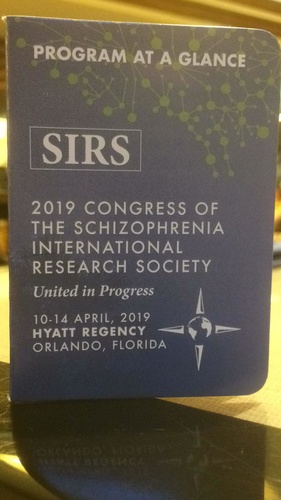
Choose a channel
Check out the different Progress in Mind content channels.

Progress in Mind

Schizophrenia is a heterogeneous disorder rather than a specific condition, William Carpenter, University of Maryland School of Medicine, Maryland, USA, told delegates at SIRS 2019. Its symptomatic deconstruction is already generating new ways of understanding its underlying pathophysiological mechanisms that may possibly guide future diagnostic procedures.
The Bipolar–Schizophrenia Network on Intermediate Phenotypes (B-SNIP) seeks to develop classifications of the symptoms of schizophrenia and bipolar disorder based on biological measurements which may be effective at identifying causes and treatments for patients.
B-SNIP1 study has already shown, using EEG and cognitive data collected from patients with schizophrenia, schizoaffective disorder and bipolar disorder with psychosis, to pool and rearrange the elements of psychosis to generate three different biotypes Brett Clementz, University of Georgia, Georgia, USA reported. These biotypes were biologically distinct, rather than a statistical anomaly was ascertained using the intrinsic brain activity (IA) data normally discarded from EEG paired stimuli task assessments. A further B-SNIP study, B-SNIP2, has replicated the findings of B-SNIP1 in an independent patient sample, supporting that subtype groupings appear real.
The biotypes were biologically distinct rather than a statistical anomaly was ascertained using intrinsic brain activity (IA) data
The B-SNIP1 data were then further analyzed to determine whether the IA patterns seen in each of the three identified subgroups (i.e. subgroups 1, 2 and 3) responded differently to second generation antipsychotics and to mood modifiers.
Subgroup 1 was defined by its low IA. The prediction was made that in patients receiving a second generation antipsychotic the IA would appear closer to normal and healthy levels in this treatment subgroup, while in those receiving a mood modifier the opposite effect would be seen, taking the IA further from the healthy level. Subgroup 2 was defined by its high IA. Thus, the predicted effects of use of a second generation antipsychotics and a mood enhancers in this subgroup would be to take the IA further from and closer to normal health levels, respectively. The effects obtained with both drug types were as predicted. Interestingly, the results were less clear when patients were classified according to DSM criteria.
IA appears a valuable means of grouping patients into more homogeneous sets and may, as suggested by this analysis, provide a means of predicting treatment response in psychosis.
The Research Domain Criteria (RdoC) paradigm offers another approach to untangling the heterogeneity of psychopathology. RdoC examines the basic neurological mechanisms and underlying pathologies in what are currently classified as different mental health disorders to see if there are common themes and pathologies.
RdoC examines the basic neurological mechanisms and underlying pathologies in what are currently classified as different mental health disorders to see if there are common themes and pathologies.
Aristotle Voineskos, Centre for Addiction and Mental Health, Toronto, described a functional magnetic resonance imaging (fMRI) study, which used hierarchical clustering to identify subgroups of individuals with similar brain activity patterns, who had been diagnosed with schizophrenia spectrum disorder. Hierarchical clustering (also called hierarchical cluster analysis or HCA) is a method of cluster analysis, which seeks to build a hierarchy of clusters and is a technique used in data mining and statistical analysis.
A total of 179 individuals took part in the Social Processes Initiative in Neurobiology of the Schizophrenias (SPINS) study; 109 has been diagnosed with a schizophrenia spectrum disorder and 70 healthy control. All recruits underwent a facial imitate/observe task while undergoing fMRI scanning at three sites. Hierarchical clustering identified new data-driven groups. Social and neurocognitive tests completed outside the scanner were compared among the new groups to determine whether they really differed in this regard.
And they did. Three clusters with distinct patterns of neural activity were identified – typical, hyperactivating and deactivating. Of the three, the deactivating group had the highest social cognitive and neurocognitive test scores. These were separable and replicable neural strategies noted during a socio-emotional task independent of DSM diagnosis or scan site. As Professor Voineskos commented, we cannot assume that people activate their brains in the same way. We have here three groups with very different patterns of brain activity.
The Hierarchical Taxonomy Of Psychopathology (HiTOP) system attempts to improve the organization, description, and measurement of psychopathology. Roman Kotov described a systematic review of the psychometric and validity evidence gathered from the Suffolk County mental health project – an epidemiological study of psychotic disorders – using this HiTOP approach.
Schizophrenia could be described in terms of two distinct spectra - psychotism and detachment - both of which are amenable targets for etiologic and treatment research
Schizophrenia could be described in terms of two distinct spectra - psychotism and detachment - both of which are amenable targets for etiologic and treatment research. Validated measures for the assessment of both spectra already exist. HiTOP methodology could facilitate reliable and valid characterization of patients with schizophrenia in the near future.
Our correspondent’s highlights from the symposium are meant as a fair representation of the scientific content presented. The views and opinions expressed on this page do not necessarily reflect those of Lundbeck.